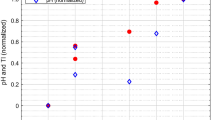Abstract
Introduction of hypothermia therapy as a neuroprotection therapy after hypoxia-ischemia in newborn infants requires appraisal of cooling methods. In this numerical study thermal simulations were performed to test the hypothesis that cooling of the surface of the cranium by the application of a cooling bonnet significantly reduces deep brain temperature and produces a temperature differential between the deep brain and the body core. A realistic three-dimensional (3-D) computer model of infant head anatomy was used, derived from magnetic resonance data from a newborn infant. Temperature distributions were calculated using the Pennes heatsink model. The cooling bonnet was at a constant temperature of 10°C. When modeling head cooling only, a constant body core temperature of 37°C was imposed. The computed result showed no significant cooling of the deep brain regions, only the very superficial regions of the brain are cooled to temperatures of 33–34°C. Poor efficacy of head cooling was still found after a considerable increase in the modeled thermal conductivities of the skin and skull, or after a decrease in perfusion. The results for the heatsink thermal model of the infant head were confirmed by comparison of results computed for a scaled down adult head, using both the heatsink description and a discrete vessel thermal model with both anatomy and vasculature obtained from MR data. The results indicate that significant reduction in brain temperature will only be achieved if the infant's core temperature is lowered.
Similar content being viewed by others
Log in or create a free account to read this content
Gain free access to this article, as well as selected content from this journal and more on nature.com
or
Abbreviations
- CBF:
-
cerebral blood flow
- 3-D:
-
three-dimensional
- MRI:
-
magnetic resonance imaging
References
Colbourne F, Corbett D 1995 Delayed postischemic hypothermia: a six month survival study using behavioral and histological assessments of neuroprotection. J Neurosci 15: 7250–7260.
Sirimanne E, Blumberg RM, Bossano D, Gunning M, Edwards AD, Gluckman PD, Williams CE 1996 The effect of prolonged modification of cerebral temperature on outcome following hypoxic-ischaemic brain injury in the infant rat. Pediatr Res 39: 591–597.
Thoresen M, Penrice J, Lorek A, Cady E, Wylezinska M, Kirkbride V, Cooper C, Brown GC, Edwards AD, Wyatt JS, Reynolds EOR 1995 Mild hypothermia following severe transient hypoxia-ischaemia ameliorates delayed cerebral energy failure in the newborn piglet. Pediatr Res 37: 667–670.
Gunn AJ, Gunn TR, de Haan HH, Williams CE, Gluckman PD 1997 Dramatic neuronal rescue with prolonged selective head cooling after ischemia in fetal lambs. J Clin Invest 99: 248–256.
Thoresen M, Satas S, Puka-Sundvall M, Whitelaw A, Hallestrom A, Loberg E, Ungerstedt U, Steen PA, Hagberg H 1997 Post-hypoxic hypothermia reduces cerebrocortical release of NO and excitotoxins. Neuroreport 8: 3359–3362.
Edwards AD, Yue X, Squier MV, Thoresen M, Cady EB, Penrice J, Cooper C, Wyatt JS, Reynolds EOR, Mehmet H 1995 Specific inhibition of apoptosis after cerebral hypoxia-ischaemia by moderate post-insult hypothermia. Biochem Biophys Res Commun 217: 1193–1199.
Gunn AJ, Gluckman PD, Gunn TR 1998 Selective head cooling in newborn infants after perinatal asphyxia: a safety study. Pediatrics 102: 885–892.
Azzopardi D, Cowan FM, Robertson NJ, Edwards AD 1999 Mild whole body hypothermia following birth asphyxia. Pediatr Res 45: 908abstr
Cady EB, D'Souza PC, Penrice J, Lorek A 1995 The estimation of local brain temperature by in vivo 1H magnetic resonance spectroscopy. Magn Reson Med 33: 862–867.
Mellergard P 1992 Changes in human intracerebral temperature in response to different methods of brain cooling. Neurosurgery 31: 671–677.
Rutherford MA, Pennock J, Counsell S, Mercuri E, Cowan F, Dubowitz L, Edwards AD 1998 Abnormal magnetic resonance signal in the internal capsule predicts poor neurodevelopmental outcome in infants with hypoxic-ischaemic encephalopathy. Pediatrics 102: 323–328.
Pennes HH 1948 Analysis of tissue and arterial blood temperature in the resting human forearm. J Appl Physiol 1: 93–122.
Van der Koijk JF, Lagendijk JJW, Crezee J, De Bree J, Kotte ANTJ, Van Leeuwen GMJ, Battermann JJ 1997 The influence of vasculature on temperature distributions in MECS interstitial hyperthermia: importance of longitudinal control. Int J Hyperther 13: 365–385.
Rawnsley RJ, Roemer RB, Dutton AW 1994 The simulation of discrete vessel effects in experimental hyperthermia. J Biomech Eng 116: 256–262.
Gagge AP, Nishi Y 1977 Heat exchange between human skin surface and thermal environment. In: D Lee (ed) Handbook of Physiology. Section 9: Reactions to Environmental Agents. American Physiological Society, Bethesda, 69–92.
Van Leeuwen GMJ, Lagendijk JJW, Van Leersum BJAM, Zwamborn APM, Hornsleth SN, Kotte ANTJ 1999 Calculation of change in brain temperatures due to exposure to a mobile phone. Phys Med Biol 44: 2367–2379.
Van Leeuwen GMJ, Kotte ANTJ, Lagendijk JJW 1998 A flexible algorithm for construction of 3-D vessel networks for use in thermal modeling. IEEE Trans Biomed Eng 45: 596–604.
Kotte ANTJ, Van Leeuwen GMJ, De Bree J, Van der Koijk JF, Crezee J, Lagendijk JJW 1996 A description of discrete vessel segments in thermal modeling of tissues. Phys Med Biol 41: 865–884.
Kotte ANTJ, Van Leeuwen GMJ, Lagendijk JJW 1999 Modeling the thermal impact of a discrete vessel tree. Phys Med Biol 44: 57–74.
Van Leeuwen GMJ, Kotte ANTJ, Crezee J, Lagendijk JJW 1997 Tests of the geometrical description of blood vessels in a thermal model using counter-current geometries. Phys Med Biol 42: 1515–1532.
Weinbaum S, Jiji LM 1985 A new simplified bioheat equation for the effect of blood flow on local average tissue temperature. J Biomech Eng 107: 131–139.
Hand JW, Lau RW, Lagendijk JJW, Ling J, Burl M, Young IR 1999 Electromagnetic and thermal modeling of SAR and temperature fields in tissue due to an RF decoupling coil. Magn Reson Med 42: 183–192.
Raaymakers BW, Crezee J, Lagendijk JJW 1998 Comparison of temperature distributions in interstitial hyperthermia: experiments in bovine tongues versus generic simulations. Phys Med Biol 43: 1199–1214.
Nelson DA, Nunneley SA 1998 Brain temperature and limits on transcranial cooling in humans: quantitative modeling results. Eur J Appl Physiol 78: 353–359.
Xu X, Tikuisis P, Giesbrecht G 1999 A mathematical model for human brain cooling during cold-water near-drowning. J Appl Physiol 86: 265–272.
Author information
Authors and Affiliations
Additional information
This work was supported in part by the UK Engineering and Physical Sciences Research Council (EPSRC), and the Garfield Weston Foundation.
Rights and permissions
About this article
Cite this article
van Leeuwen, G., Hand, J., Lagendijk, J. et al. Numerical Modeling of Temperature Distributions within the Neonatal Head. Pediatr Res 48, 351–356 (2000). https://doi.org/10.1203/00006450-200009000-00015
Received:
Accepted:
Issue date:
DOI: https://doi.org/10.1203/00006450-200009000-00015
This article is cited by
-
Comparisons of healthy human brain temperature predicted from biophysical modeling and measured with whole brain MR thermometry
Scientific Reports (2022)
-
Fluid dynamic and thermal comfort analysis in an actual operating room with unidirectional airflow system
Building Simulation (2021)
-
How does blood regulate cerebral temperatures during hypothermia?
Scientific Reports (2018)
-
Natural convection heat transfer coefficient for newborn baby
Heat and Mass Transfer (2018)
-
A model based on the Pennes bioheat transfer equation is valid in normal brain tissue but not brain tissue suffering focal ischaemia
Australasian Physical & Engineering Sciences in Medicine (2017)



